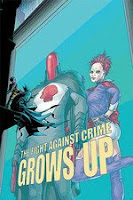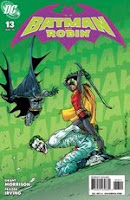Once again I dove back into the waters of Grant Morrison writing, despite my less than favorable previous forays. Not that I'm being plangent here. I enjoyed All-Star Superman, but I don't ascribe it to high literature like so many others. Too much dancing around and showing off the writer's prowess rather than getting on with the story.

Truthfully, what pulled me in to giving this series a try was Frank Quitely's art. Love that guy's line work. Hell, even when he was just doing covers after the first three issues, there was a siren quality to his work. His work in those three issues certainly influenced and shaped what Philip Tan, Cameron Stewart, Andy Clarke and Frazier Irving did in the remaining 16 issues I'll be addressing here.
The first three issues took off running, which was great. We had the introduction of European circus geeks, especially Professor Pyg, as villains fitting the Dick Grayson Batman to a T. The return of the Red Hood and the introduction of Scarlett as vigilantes crossing some lines occupied the fourth through sixth issues, and also introduced the Flamingo, an assassin who seems a bit too much. This is Morrison showing off, in my opinion. What criminal organization is going to create, let alone use, a guy who's totally uncontrollable. He eats the faces off the people the cartel hires to bring him to Gotham to get Batman and Robin. That's just stupid. No cartel is going to want an employee that's out of control like that.
T. The return of the Red Hood and the introduction of Scarlett as vigilantes crossing some lines occupied the fourth through sixth issues, and also introduced the Flamingo, an assassin who seems a bit too much. This is Morrison showing off, in my opinion. What criminal organization is going to create, let alone use, a guy who's totally uncontrollable. He eats the faces off the people the cartel hires to bring him to Gotham to get Batman and Robin. That's just stupid. No cartel is going to want an employee that's out of control like that.
 T. The return of the Red Hood and the introduction of Scarlett as vigilantes crossing some lines occupied the fourth through sixth issues, and also introduced the Flamingo, an assassin who seems a bit too much. This is Morrison showing off, in my opinion. What criminal organization is going to create, let alone use, a guy who's totally uncontrollable. He eats the faces off the people the cartel hires to bring him to Gotham to get Batman and Robin. That's just stupid. No cartel is going to want an employee that's out of control like that.
T. The return of the Red Hood and the introduction of Scarlett as vigilantes crossing some lines occupied the fourth through sixth issues, and also introduced the Flamingo, an assassin who seems a bit too much. This is Morrison showing off, in my opinion. What criminal organization is going to create, let alone use, a guy who's totally uncontrollable. He eats the faces off the people the cartel hires to bring him to Gotham to get Batman and Robin. That's just stupid. No cartel is going to want an employee that's out of control like that. Issues 7-9 then send Batman off to England while Robin recovers from spinal damage suffered in the previous arc. This revives Knight, a UK version of Batman inspired by the original, and his sidekick, Squire, a female version of Robin. Batman is trying to return Bruce Wayne to life by taking what he believes to be Wayne's body to a Lazarus Pit in England. Of course, it's not actually Bruce Wayne but a doppelganger, so it's got Wayne's memories but is totally insane and deteriorating. Kind of a Bizzaro Batman, really. There's a good guest appearance of Batwoman, despite the infamous problems with the word balloons between her and Batman being reversed. I especially liked her toughness in having Batman kill he to revive her in the Lazarus Pit. Very much in keeping with how her character had been developed in Detective Comics.
Issues 7-9 then send Batman off to England while Robin recovers from spinal damage suffered in the previous arc. This revives Knight, a UK version of Batman inspired by the original, and his sidekick, Squire, a female version of Robin. Batman is trying to return Bruce Wayne to life by taking what he believes to be Wayne's body to a Lazarus Pit in England. Of course, it's not actually Bruce Wayne but a doppelganger, so it's got Wayne's memories but is totally insane and deteriorating. Kind of a Bizzaro Batman, really. There's a good guest appearance of Batwoman, despite the infamous problems with the word balloons between her and Batman being reversed. I especially liked her toughness in having Batman kill he to revive her in the Lazarus Pit. Very much in keeping with how her character had been developed in Detective Comics.
Issues 10-15 wrap things up on Morrison's run. This ultimately leads to the return of the time displaced Bruce Wayne. The problem with this arc is that it's clearly referencing things going on in other books. The 17th century Thomas Wayne shows up claiming to be Bruce's father of the same name. He's bent on destroying everything and operates under the nom du guerre Black Glove, as well as assuming the identity of Thomas Wayne. There's a hallucinogenic quality to a lot of this arc. Some of it has to do with how Morrison lays things out from Thomas Wayne's perspective and some has to do with things happening in other books that are only implied here.

Morrison throws in the Joker using the identity of Oberon Sexton, the Gravedigger, to get close to Batman and Robin. Amusingly, Joker is working on the same side as Batman and Robin because he's out to destroy Thomas Wayne himself. I have a hard time buying the Joker being able to pull off that impersonation. Sexton is supposed to be rational. Joker is hardly that, and he's pulling this off for days, if not weeks. I appreciate the intent here, and Joker's disguised himself as other people on other occasions, but unless it's someone else who's unstable, I have a hard time buying that.
Concurrently, Robin's having trouble with his body being controlled by someone else. Seems his mother, when having his spine repaired, implanted neural control technology. Talia now has Deathstroke using Robin's body to try to kill Batman. That doesn't work out so well and Deathstroke ends up the worse for wear.

As I said, I did enjoy this run, over all, but it suffers from the usual Morrison showiness. Oft times I felt like there were insular things that were being slipped by me. I'm not a Batman worshipper, after all. I certainly wouldn't recommend this to anyone who wasn't already familiar with the Batman mythos. Someone who isn't would have a hard time figuring out Talia's relationship to Bruce Wayne, beyond being the mother to Damien, his son. There's a depth to that relationship that you have to know already. Similarly, it's none too clear that the older guy helping out Batwoman is her father unless you've already read the Detective Comics stories. And don't even get me started on all the inside stuff with Oberon Sexton/Joker or the whole Red Hood dynamic.
What I liked most was the development of Professor Pyg. That's a great new villain that I hope will be around for awhile. I also very much enjoyed the characterization of Damien as Robin. He makes this duo far more interesting than the old Bruce Wayne/Dick Grayson dynamic that's most familiar to the public at large. Outside the frequent readers of comics, people are almost totally unaware of Nightwing, really. Morrison throws a lot into these 16 issues, which makes it all the more amazing that there was a lot going on elsewhere in the revivial of Bruce Wayne. It reached an inevitable conclusion with the return of Bruce Wayne, yet remained an interesting, if less than accessible, tale. It was kept to the appropriate scale for a Batman and Robin milieu. No cosmic menaces. Hell, none of the villains even had any super powers of any kind, nor did the protagonists. Ok, Deathstroke has enhanced senses, but he wasn't directly fighting anyone. The closest thing to a power in these 16 issues was longevity.
Unfortunately, the following three issues by Paul Cornell weren't at all interesting and I dropped the book. Peter Tomasi's on it now, but I haven't been thrilled enough with his work to take a flyer on returning. Perhaps another day.
No comments:
Post a Comment